Abbazia di Novacella
(An Online Virtual Visit)
by
Terry Sullivan
Photos provided by
Abbazia di Novacella unless otherwise noted.
This article about Abbazia di Novacella is based on an online interview, online data and photos supplied by the winery. The winery graciously sent a sample of wine. The article was written during the time of the worldwide 2020-2021 pandemic. Werner Waldboth, Head of Sales responded to our questions.
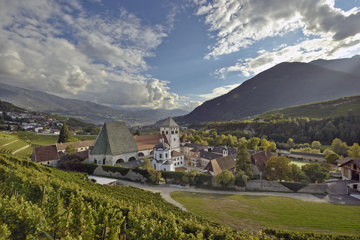 Summary: One of the oldest continuously producing wineries in Italy as well as the world is Abbazia di Novacella. The abbey, in Novacella, South Tyrol, was founded in 1142 by the Augustine Order of Canons Regular. (Image right © Georg Bühler via Abbazia di Novacella.)
Summary: One of the oldest continuously producing wineries in Italy as well as the world is Abbazia di Novacella. The abbey, in Novacella, South Tyrol, was founded in 1142 by the Augustine Order of Canons Regular. (Image right © Georg Bühler via Abbazia di Novacella.)
Our questions were answered by Werner Waldboth, Head of Sales. We asked him how he became interested in wine. Werner wrote,
“My parents did own a restaurant and therefore wine always played a role in my life. After my studies and a couple of years in the tourism industry I started to work for the Alto Adige wine marketing board and the passion for wine became my profession.”
History
Since the year 1142, the monks at the Abbey have continued to produce quality wines for nearly one thousand years. The focus today as well as in the past has been the quality of their wine in the glass. In addition to the vows of poverty, chastity and obedience, the monks through the years have had to support themselves. They have done this by planting grapes and making wines. They also plant fruit and vegetables and run a small school devoted to viticulture. Today the monks do not produce the wine as they are totally involved in their many parishes.
Vineyards
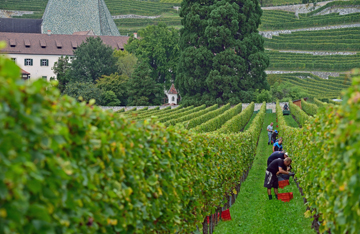 The winery owns some vineyards (pictured left © Albert Ceolan via Abbazia di Novacella) and sources grapes from over 50 growers in the region. Near the winery in Novacella white grape varieties are planted including Kerner, Müller-Thurgau, Riesling and Sylvaner. Red grape varieties Schiava and Pinot Nero (Pinot Noir) are planted about an hour further south near Lago di Caldaro; the red grape, Lagrein is planted at their estate in Bolzano about 45 minutes south of the winery.
The winery owns some vineyards (pictured left © Albert Ceolan via Abbazia di Novacella) and sources grapes from over 50 growers in the region. Near the winery in Novacella white grape varieties are planted including Kerner, Müller-Thurgau, Riesling and Sylvaner. Red grape varieties Schiava and Pinot Nero (Pinot Noir) are planted about an hour further south near Lago di Caldaro; the red grape, Lagrein is planted at their estate in Bolzano about 45 minutes south of the winery.
Werner Waldboth mentioned the vineyards near the winery.
“We are not just the northernmost wine region in Alto Adige and therefore in the whole Italy, but our vineyards are on higher elevations, too. Therefore we have a very cool climate here. In addition with the permeable and mineral-rich soils, here you can find the perfect conditions for growing cool climate grape varieties.”
We were interested in the grape varieties planted by the winery over a thousand years. Werner Waldboth wrote:
“There have been a lot of different varieties, but until a 100 years ago mostly indigenous varieties such as Blaterle, or white Lagrein were planted. Only in the 20th century did the winery start to work with the grape varieties we have today: Sylvaner, Riesling, Grüner Veltliner, Kerner, Pinot Grigio… .”
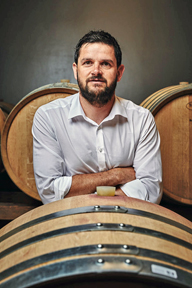 Schiava and Lagrein are planted in Alto Adige as well as a few other places in the world. They do not have the name recognition as the international grapes have. Wine Trail Traveler asked, "What is the local’s public’s perception of wines made with indigenous grapes such as Lagrein or Schiava?" Werner Waldboth (pictured right) responded,
Schiava and Lagrein are planted in Alto Adige as well as a few other places in the world. They do not have the name recognition as the international grapes have. Wine Trail Traveler asked, "What is the local’s public’s perception of wines made with indigenous grapes such as Lagrein or Schiava?" Werner Waldboth (pictured right) responded,
“As we are located in Valley Isarco, so our core varieties are whites, but we do own some vineyards further south and therefore we also have Lagrein and Schiava. Schiava has always been the wine for every day for the locals. If you are going to a bar in a typical traditional village in Alto Adige at let’s say 11AM, at the counter you almost certainly have a couple of older gentlemen drinking a glass of Schiava. It’s simply part of our culture.
“Lagrein came a little bit later. Until the late 70s the variety was used mostly to color the Schiava or to make a rosè wine called Lagrein Kretzer. But the younger generation mostly prefers these wines, as they are more structured.”
Werner Waldboth continued to mention Schiava and Lagrein on the international market.
“The Schiava had a hard time during the 80s and 90s and even until a couple of years ago. In 1983, 68% of the vineyard area in Alto Adige was planted with Schiava. At that time Alto Adige produced mostly light red wines for the German, Austrian and Swiss market. At the beginning of the 80s the interest in these wines was strongly declining probably because there was a shift in the drinking habits from light wines to more intense wines. Today we have a lot less Schiava, it’s only some 11% of the vineyard area. In addition there is a growing interest in light wines and therefore in Schiava as well. Therefore I think there is some good potential for this variety on the international market.
“For Lagrein we see some increasing interest as well. Wine lovers are searching for specialties and for wines which are typical for a region.”
Winemaking
Celestino Lucin has been the winemaker at Abbazia di Novacella for over two decades. His focus is to craft quality wines that people will enjoy. Perhaps in the future there may be some wines made from single vineyards.
Wine
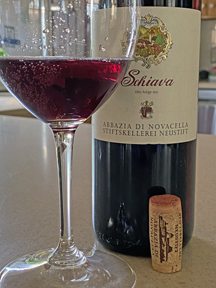 We received a sample of a 2020 Schiava, Alto Adige ((pictured left, Wine Trail Traveler). The grapes for this Schiava were grown in the Cornaiano cultivation zone. The wine was fermented on its skins for five days then went through malolactic fermentation and five months of maturation in stainless steel tanks. The 12.5% alcohol wine had a translucent, bright, dark, red color. The aroma was reminiscent of red berry fruits. The taste included red raspberries and strawberries. The wine had a medium body with mild tannins. The finish was crisp and fruity with a faint hint of almonds and an autumn stroll in the forest. The wine was light and refreshing, a perfect red for a September day as one transitions from the white cool wines in summer’s heat to the red wines during winter’s touch.
We received a sample of a 2020 Schiava, Alto Adige ((pictured left, Wine Trail Traveler). The grapes for this Schiava were grown in the Cornaiano cultivation zone. The wine was fermented on its skins for five days then went through malolactic fermentation and five months of maturation in stainless steel tanks. The 12.5% alcohol wine had a translucent, bright, dark, red color. The aroma was reminiscent of red berry fruits. The taste included red raspberries and strawberries. The wine had a medium body with mild tannins. The finish was crisp and fruity with a faint hint of almonds and an autumn stroll in the forest. The wine was light and refreshing, a perfect red for a September day as one transitions from the white cool wines in summer’s heat to the red wines during winter’s touch.
Wine Tourism
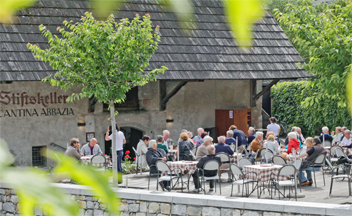 The winery is not open to the public; however, wine enthusiasts can visit the vineyards and monastery (pictured right © Jasmin Deporta via Abbazia di Novacella). There is also a museum they can visit to gain knowledge about the Augustine Order of Canons Regular and the monastery’s history. Tours are offered in Italian and German. Tours in English and French can also be offered upon request. Werner Waldboth added, “We are one of the biggest monasteries in our area and a beautiful place to visit.”
The winery is not open to the public; however, wine enthusiasts can visit the vineyards and monastery (pictured right © Jasmin Deporta via Abbazia di Novacella). There is also a museum they can visit to gain knowledge about the Augustine Order of Canons Regular and the monastery’s history. Tours are offered in Italian and German. Tours in English and French can also be offered upon request. Werner Waldboth added, “We are one of the biggest monasteries in our area and a beautiful place to visit.”
During the pandemic, the winery has had some online tastings and increased their use of social media. They are looking forward to the time when they can offer their usual presentation. Werner Waldboth summed it up by writing, “Wine tastes better when drunk in good company and therefore the best way to reach out to wine enthusiasts is to share the wines together.”
Wine travelers can enjoy a visit to one of the oldest continuous wine producers in Italy and the world. The history of the monastery, wine production and tasting the wines in a beautiful place is ripe for a wine journey.
Abbazia di Novacella
Via Abbazia, 1, 39040 Novacella BZ, Italy
Article written September 2021.
Visit these tour operators that partner with Wine Trail Traveler.
 |
||||
|
Spain and Portugal |
SmoothRed London, England, United Kingdom |
